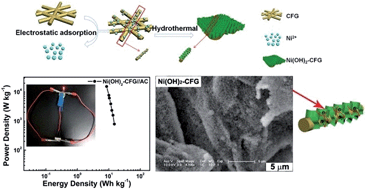A vertical and cross-linked Ni(OH)2 network on cellulose-fiber covered with graphene as a binder-free electrode for advanced asymmetric supercapacitors†
Abstract
Nanostructured transition metal oxides are attractive pseudocapacitive materials with high theoretical specific capacitance, scale-up potential and environmental benignity. However, realizing high capacitance and excellent rate capability remains a critical challenge. Herein, a three-dimensional carbon support of cellulose-fiber covered with graphene (CFG) to induce the growth of a hierarchical nanostructured Ni(OH)2 (Ni(OH)2–CFG) is fabricated through a one-pot hydrothermal reaction without using any surfactants or hard templates. The resulting Ni(OH)2–CFG composite exhibits a special vertical and cross-linked network structure with a large surface area (425.9 m2 g−1, higher than that of unsupported Ni(OH)2, 366.9 m2 g−1) and appropriate pore size distribution of micro–mesopores, which offer fast electrolyte ion-transport and short ion-diffusion pathways. Electrochemical characterization demonstrates that the Ni(OH)2–CFG composite as a binder-free electrode reveals high mass capacitance (2276 F g−1, at 1 A g−1), good rate capability and excellent cycling stability (no capacitance decay after 1000 cycles at a high current density of 5 A g−1). In addition, an asymmetric Ni(OH)2–CFG//activated carbon supercapacitor exhibits a high cell-voltage of 1.6 V and a maximum specific capacitance of 191.3 F g−1 with an energy density up to 15.0 W h kg−1. The excellent performances of the Ni(OH)2–CFG composite demonstrate its promising potential for future capacitor based energy storage and conversion.


 Please wait while we load your content...
Please wait while we load your content...